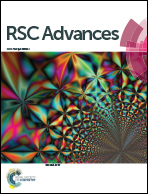Single-protein-based theranostic nanosystem within sub-10 nm scale for tumor imaging and therapy
Abstract
A single-protein-based theranostic nanosystem (SPTN) based on non-covalent interaction between bovine serum albumin (BSA), gadolinium (Gd) and the anticancer hydrophobic drug doxorubicin (DOX) was designed and developed via a facile, environmentally benign approach. Gd was incorporated into the structure of BSA via a simple biomineralization process, while DOX was encapsulated in Gd–BSA nanoparticles via hydrophobic interaction between DOX and BSA, as well as a coordination effect between DOX and Gd. The whole SPTN system was kept in one single BSA molecule to form a single protein based nanosystem with an overall size of around 7 nm favorable for potential renal clearance. The SPTN nanosystem showed not only robust biocompatibility, excellent T1-weighted MR imaging effect but also fine pH-responsive drug release characteristics. Furthermore, in vivo therapeutic efficacy experiment showed that the nanoparticle DOX–Gd–BSA had an obvious therapeutic efficacy toward hepatoma tumor bearing mice.


 Please wait while we load your content...
Please wait while we load your content...